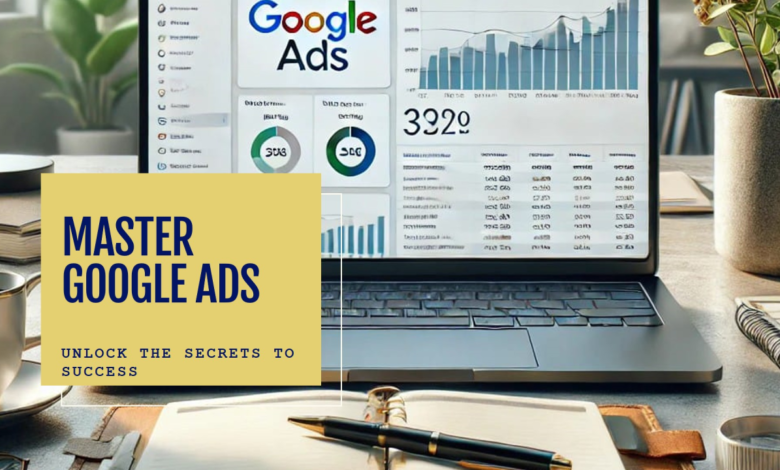Google Ads Mastery: A Complete Guide to Running High-Performance Campaigns in 20251. Introduction

Digital marketing has become indispensable for businesses aiming to stand out in today’s highly competitive online environment. Among the various methods available, Google Ads stands out as one of the most powerful and effective ways to reach your target audience. Whether you’re looking to promote a new product or gain brand recognition, Google Ads offers a scalable, data-driven platform that can help you connect with potential customers at precisely the right moment. In this article, we’ll explore the fundamentals of Google Ads, discuss how it can benefit your business, and provide best practices for running successful campaigns.
2. Understanding Google Ads
2.1. What Is Google Ads?
Google Ads (formerly known as Google AdWords) is an online advertising platform developed by Google. It enables businesses to display brief advertisements, service offerings, product listings, or videos to users across the Google Search Network, Google Display Network, YouTube, and more. Unlike organic search engine optimization (SEO), which can take time to show results, Google Ads offers an immediate way to get your brand in front of potential customers.
2.2. How Does It Work?
Google Ads operates on a pay-per-click (PPC) model, meaning advertisers pay only when users click on their ads. When someone types in a search query, Google runs an automated auction to determine which ads will show up at the top of the search engine results page (SERP). Advertisers bid on keywords relevant to their products or services, and Google considers various factors—such as the bid amount, ad relevance, and landing page quality—to decide which ads to display.
3. Why Google Ads Is Essential for Businesses
3.1. Immediate Visibility
While optimizing your website for organic search is essential, it can take months to see significant movement in rankings. By contrast, Google Ads can catapult your business to the top of the search results almost instantly, allowing you to reach a broad audience in a short period.
3.2. Targeted Reach
Google Ads allows you to zero in on your ideal audience by location, language, device type, and even interests or online behaviors. Advanced targeting features ensure your ads are seen by those who are most likely to take action—be it making a purchase, signing up for a newsletter, or requesting a quote.
3.3. Measurable Outcomes
One of the key strengths of Google Ads is its robust analytics suite. Advertisers can track everything from clicks and impressions to conversions and return on ad spend (ROAS). This helps in making data-driven decisions and optimizing campaigns for better results.
3.4. Scalable Budget
Whether you’re a small startup or a global corporation, Google Ads accommodates budgets of any size. You set the maximum amount you’re willing to spend, and Google will automatically manage your bids to maximize your returns within that limit.
4. Types of Google Ads Campaigns
4.1. Search Campaigns
Search campaigns display text ads on Google’s search results pages. These campaigns are excellent for capturing users actively searching for products or services similar to yours.
4.2. Display Campaigns
Display campaigns show visually engaging ads (images, banners, or rich media) across Google’s Display Network, which includes millions of websites, blogs, and apps. They’re ideal for brand awareness and retargeting.
4.3. Video Campaigns
Video campaigns let you place ads on YouTube and other Google video partner sites. With the growing popularity of video content, this is a powerful way to showcase your brand personality and educate viewers.
4.4. Shopping Campaigns
Shopping campaigns are particularly useful for e-commerce businesses, allowing you to display product images, prices, and store information directly in search results.
4.5. App Campaigns
App campaigns are designed to drive app downloads or engagement, promoting your mobile application across Google Search, Play Store, YouTube, and other channels.
5. Setting Up a Successful Google Ads Campaign
5.1. Keyword Research
Your campaign’s success largely hinges on choosing the right keywords. Tools like Google Keyword Planner can help you discover relevant search terms with high traffic and manageable competition. Aim for a balanced mix of broad, phrase, and exact match keywords to capture various user intents.
5.2. Compelling Ad Copy
Well-crafted ad copy should clearly articulate what you’re offering and why users should care. Highlight unique selling points, incorporate a strong call-to-action (CTA), and ensure that your landing page content aligns with the ad’s promises to maintain consistency.
5.3. Bid Strategy
Google Ads allows for automated and manual bidding strategies. Automated bidding options like “Maximize Conversions” or “Target CPA” use machine learning to optimize bids in real time. However, manual bidding gives you greater control if you have a clear understanding of your keyword performance and target audience.
5.4. Conversion Tracking
Implementing conversion tracking is crucial. Whether it’s completing a purchase, filling out a lead form, or downloading an app, tracking user actions allows you to measure ROI and optimize campaigns effectively.
5.5. Ongoing Optimization
A well-executed Google Ads strategy isn’t static. You’ll need to regularly review performance metrics, perform A/B tests on ad creatives, adjust bids, and refine keyword lists to maintain strong results over time.
6. Best Practices for Google Ads
- Quality Score Matters: Improve ad relevance, landing page experience, and click-through rate (CTR) to boost your Quality Score, which can lower costs and improve ad positioning.
- Use Negative Keywords: Filtering out irrelevant queries can save you money and improve campaign efficiency.
- Segment Your Campaigns: Categorize campaigns by product, service, or geographic region for easier management and optimization.
- Leverage Ad Extensions: Include additional details—like phone numbers, site links, or special offers—to increase your ads’ real estate and CTR.
- Mobile Optimization: Ensure your website and ads are optimized for mobile users, as a significant portion of online searches come from smartphones.
7. Common Pitfalls to Avoid
- Ignoring Match Types: Using only broad match keywords can waste budget on irrelevant clicks.
- Overlooking Landing Pages: Even the best ads won’t convert if the landing page experience is poor or mismatched.
- Neglecting Testing: Failing to conduct regular A/B tests on ad copy, design, and targeting can lead to stagnant results.
- Poor Budget Management: Without strategic bid adjustments, you risk overspending without sufficient returns.
- Lack of Tracking: Not implementing conversion tracking makes it impossible to accurately measure campaign performance.
8. Conclusion
Google Ads is more than just a tool—it’s a dynamic marketing ecosystem that can propel your business to new heights when utilized effectively. Its diverse campaign types, extensive targeting capabilities, and real-time analytics make it a go-to platform for marketers aiming to drive quick, measurable results.
Whether you’re a novice just dipping your toes into paid search advertising or an experienced marketer looking to optimize your campaigns further, the key is a data-driven approach. Keep refining your strategies, running experiments, and analyzing metrics to ensure you’re getting the best bang for your buck. If you’re seeking expert assistance tailored to your unique goals and industry, consider partnering with Google Ads professionals who understand the intricacies of this robust platform.
By blending creativity with analytics and continuously adapting to user behavior, Google Ads can serve as a vital catalyst in expanding your business’s online presence and profitability. Don’t hesitate to explore its potential—your next loyal customer could be just a click away.




